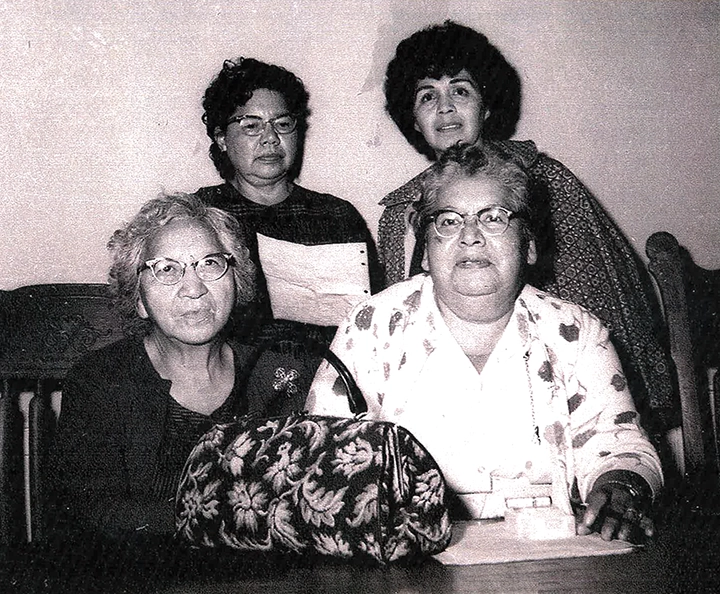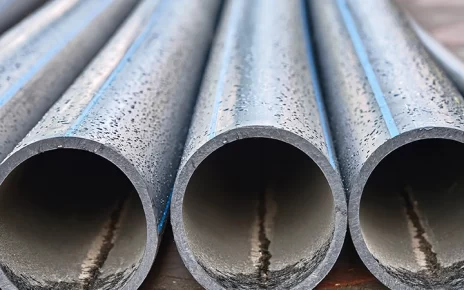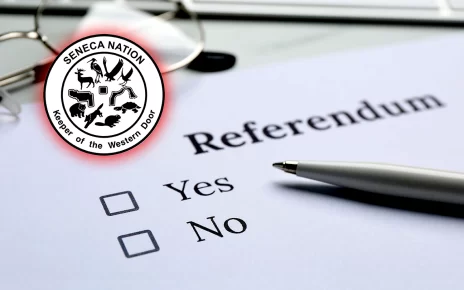Pictured above: Women from Allegany that headed up the Women’s Right to Vote Movement. Bottom: Bernice Crouse, Harriet Pierce. Top: unknown, Rovena Watt-Abrams
Seneca Suffragettes
In May of 1964, a fifth and final referendum to decide the right of Seneca women to vote was finally approved by a vote of 169 to 99. Pointing to the coming November election, President George Heron warned potential male candidates that the women “outnumber us and they intend to make their votes count.” Martin Seneca, elected president in November of 1964, gave his first state of the nation address in January 1965 saying the new administration “owes its election in part to the women.” It took five referendums for men to approve Seneca women’s suffrage (Nov. 6, 1951, Oct. 30, 1956, May 11, 1959, Oct. 27, 1962, May 23, 1964).
1845, January – Hand in hand with New York State legislation that supported the establishment of a municipal government on the Allegany and Cattaraugus Territories, the chiefs and head men of the Seneca Nation in a general council “declare[d], that our political usages, customs, organizations and constitution be…altered and amended, so that no sale or disposition of the whole or any part of our lands…shall be valid…unless the same be made in full and open Council of the Chiefs and Warriors of the Nation, and by the express assent of two-thirds of all the Chiefs, and two-thirds of the whole residue of the male population of the Nation, of the age of twenty-one years, and upwards…” Seneca women had lost their voice in regards to the land.
1848, December 4 – A constitutional convention held on the Cattaraugus Territory established an elective form of government for the Seneca Nation. Women’s authority in land dealings is restored, but they are denied the right to vote.
1887, January 19 – In the early years of the new Seneca Nation government it was a standard practice to seek the advice of the Philadelphia Society of Friends (Quakers) regarding Seneca government actions, in particular constitutional changes. In a letter on this date from Quaker Joseph Elkinton to former Seneca Nation President Henry Silverheels on the matter of proposed amendments, Elkinton seemed open to the idea of Seneca women’s suffrage. Elkinton wrote, “I do not see that your women are to vote, I think heretofore in case of a treaty making the Mothers have voted, it might be well to give the matter thought as to what you want on other occasions, but I would not favor depriving the Mothers from voting in case of any treaty as heretofore.”
1920, November 1 – It probably was not a coincidence that in the same year as the passage of the 19th amendment giving women in the U.S. the right to vote that a petition with 39 signatures of which 24 were enrolled female and male members of the Seneca Nation called for the right of Seneca women to vote and for a new form of Seneca Nation government. There is no record of this petition being presented to the Seneca Nation Council for its consideration.
1931, December 5 – The first recorded official action, or inaction, regarding Seneca women’s suffrage occurred at the Council session at Cattaraugus on this date. Councillor Jonas Crouse, a well-respected and successful farmer on the Allegany Territory, made a motion to consider amending the Seneca Nation Constitution to permit Seneca women the privilege to vote. The motion was defeated.
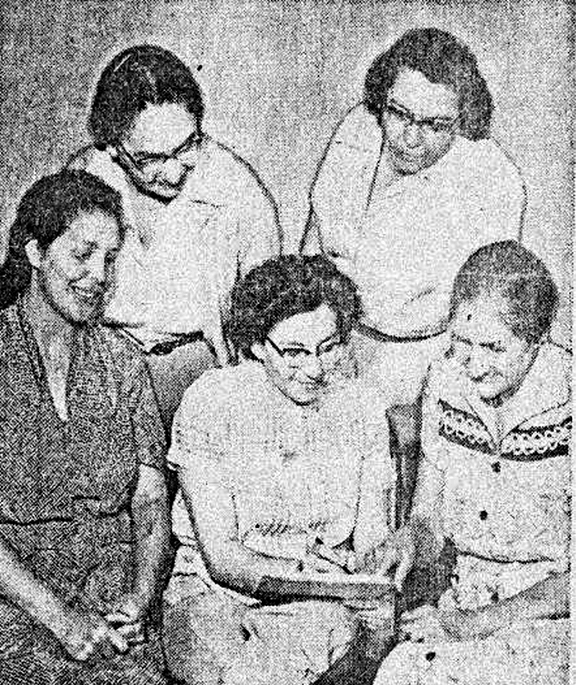
1935, April – Wilford Kennedy from the Cattaraugus Territory, wrote a letter to the U.S. Commissioner of Indian Affairs, John Collier. Kennedy’s letter favored Seneca women’s suffrage. He wrote, “I will pull for the right and I want to see my Seneca Nation a Nation that can adjust, or co-operate in matters, of both, great & small. With the Voice of the Seneca Nation to answer the call, from both Parties, men & women. . . It is no more than right to have the women as well as men to organize the Seneca Nation where it belongs. And not one-sided affair will be played, unless the women will know the cause, as well as men.” [sic]
1935, December 4 – Meeting at the Allegany courthouse in Jimersontown, Seneca women submitted a suffrage petition to the Council. Allegany Councillor George Patterson made a motion to consider the petition that one local newspaper claimed two-thirds of the women of the Nation had signed. The motion passed and Council appointed Adlai Williams, Jonathan Johnson, and Jonas Crouse to a committee to study amending the Constitution.
1935, December 21 – At a special Council at Cattaraugus the constitution committee made its report to the Council.
The Council minutes read:
Report of Committee – To the Council of the Seneca Nation of Indians. The committee appointed to consider and report an amendment to section 10 of the amended Constitution of the Seneca Nation of Indians adopted in 1898. For the purpose of extending and giving the adult women of said Nation [the right] to vote for the officers of said Nation thereby, report that they recommend that Section 10 of said constitution be amended to read as follows: Every Indian of the Seneca Nation of the age of twenty-one years and upwards, residing upon either of the reservations of the Seneca Nation, whose names appear on the last preceding roll used for the payment of annuities to the said Indians, and who shall not have been convicted of a felony shall be competent to vote at all elections and meetings of the electors of the Nation and shall be eligible to any office in the gift of the people of the Nation. The right of any Indians belonging to the Seneca Nation to vote shall not be denied or abridged on account of sex. Respectfully submitted – Adlai Williams, Jonathan Johnson, Jonas Crouse, Committee. Dated Dec. 12, 1935.
Ulysses Printup made a motion to accept and approve the report of the suffrage committee. The motion was defeated.
1946, December 6 – The Veteran’s Party, composed of young men just returned home from the war, won the general election in November 1946. Newly minted Allegany Councillor George Heron placed on the agenda the matter of women’s suffrage. There is no record of a discussion or of any actions taken.
1951, August 11 – At a special Council session Cattaraugus Councillor Morris Jimerson made a motion, seconded by Guy Patterson, that the Council consider the suffrage petition of Reva Cooper Barse. Her petition was referred “to the committee for amending the constitution” and Council designated November 6 “for the purpose of voting on proposed amendments.”
1951, November 6 – All three proposed constitutional amendments, including women’s suffrage, were defeated. A total of only 10 votes were cast at Allegany because of an organized boycott unrelated to women’s suffrage, but 130 votes were cast at Cattaraugus. Despite all 10 Allegany votes favoring women’s suffrage, the vote count at Cattaraugus was 41 in favor and 89 opposed. The final count on the first ever suffrage amendment referendum was 51 in favor and 89 opposed to women getting the right vote.
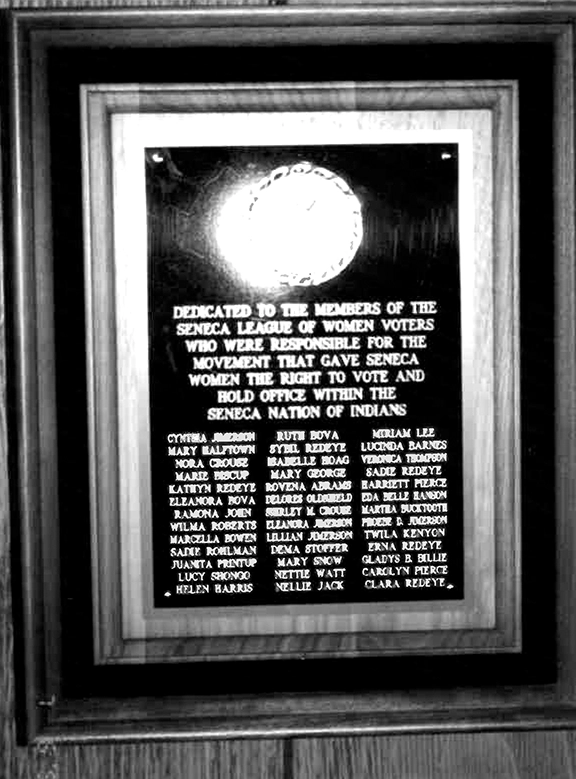
1955, December – Councillor Elmer Thompson presented a written petition on behalf of the women of the Cattaraugus Territory regarding the right to vote. He introduced a motion, seconded by Theodore Jackson, that Council entertain the petition of the women seeking the right to vote and hold office. He stated this movement was like one several years earlier at which time a committee had been appointed to make a study of women’s suffrage. The petition was again referred to a Council-appointed Constitutional Amendments Committee.
1956, March – At the regular session of Council a motion by Councillor Alton Van Aernam, seconded by Lawrence Kennedy, tabled the issue of Seneca women’s suffrage and the question was not included in a public referendum held in May of that year.
1956, June 16 – The newly organized Women’s Suffrage Organization, led by Martha Green Flammang from Cattaraugus, attended the Council session. Councillor Theodore Jackson introduced their petition and called on Martha to speak. Following much discussion Councillor Watson Pierce, despite not favoring women’s suffrage, made the motion, seconded by Coleman John, to put the question of the right of women to vote before the legal voters of the Nation in accordance with the recommendation of the Constitutional Amendments Committee. The Council motion passed by a vote of 7 to 3 with 1 abstention.
1956, October 30 – The referendum voting took place at the Coldspring Longhouse at Allegany and the courthouse at Cattaraugus. When the polls closed, the vote count showed that 195 Seneca men had voted in the second women’s suffrage referendum. The result was 105 opposed and 90 in favor of suffrage. The proposed amendment had been approved by the male voters at Cattaraugus by a 2:1 margin, but overwhelmingly defeated at Allegany.
1957, March and April – Aware of the efforts of Seneca women to gain the right to vote in Seneca Nation elections, New York State’s Joint Legislative Committee on Indian Affairs proposed legislation which was brought to the state’s Assembly and sponsored by Cattaraugus County Assemblyman Leo P. Noonan. Claiming civil and criminal jurisdiction in internal Indian affairs, Gov. Harriman signed into law a state bill that would allow women the right to vote in tribal elections provided the right was recognized by the men. But there is no mention or recognition of any influence in Seneca Nation records of the state’s attempt to meddle in the Nation’s voting debate.
1958, December 6 – Pledging support of women’s suffrage, the New Deal Party is elected to office in November. True to their word, the new Council responds to a petition from the women seeking the right to vote by designating May 9th for a referendum vote.
1959, May 9 – For the third time the proposed women’s right to vote amendment was defeated. Ninety-one men were opposed, while 61 men favored Seneca women’s suffrage.
1962, June 4 – The Council received a petition with 20 signatures of Cattaraugus women seeking the right to vote. Hilda Metzger is quoted as saying, “Now, we [women] have no voice in government or right to hold office. We amount to nothing in our Nation’s running.” She pledged that if given the vote, the women will “build up the government of the Senecas, making it more a government of the people, by the people and for the people.” President Basil Williams appointed Franklin John, DeForest Billy and Lafayette “Jack” Kennedy to consider the request and make recommendations.
1962, October 27 – For the third time the proposed amendment was defeated. This time the all-male vote was 118 opposed to women’s suffrage and 106 in favor.
1964, March 7 – At this Council session held at the former Thomas Indian School, Martha Flammang led a delegation of the Women’s Suffrage Group and presented a women’s suffrage petition containing 162 signatures. More than half of those in attendance that day were women. Following discussion on amending the constitution, Allegany Councillor Lawrence Mohr, Jr. made the motion, seconded by Delbert Crowe, to appoint Walden Jimerson, Quinton Biscup, and Elmer Steeprock to a committee for revision of the constitution.
1964, April 4 – The constitution committee made its report to the Council and a motion by Councillor Walden Jimerson, seconded by Quinton Biscup, was passed directing Clerk DeForest Billy to conduct a referendum to revise section X of the SNI Constitution no later than June 13, 1964.
1964, May 23 – A fifth referendum was held and the amendment giving Seneca women the right to vote was approved by a vote of 169 to 99. Only 268 (26%) of the 1,039 eligible Seneca male voters cast their votes that day. Paper ballot voting took place at Brennan Hall at the former Thomas Indian School on the Cattaraugus Territory and at the Coldspring Longhouse on Allegany. One newspaper article noted that the newly enfranchised “women are expected to work a drastic change in voting patterns.” Pointing to the upcoming November election, President George Heron warned the male candidates that the women “outnumber us and they intend to make their votes count.”
1964, November 3 – Three weeks before the general election, President George Heron spoke before 25 members of the newly formed League of Women Voters saying, “The Nation’s women will determine with their vote who will be elected to the presidency of the Nation.” On this day the women voted for the very first time in a Seneca Nation election since the change of government in 1848. The local newspaper reported that about half of the 1,187 Senecas who voted were women. In an interview of Sadie Marie Rohlman conducted by Dr. Randy John in the 1980s, Sadie told Randy she was the first woman at Allegany to vote in the 1964 election.
1965, January – In his first state of the Nation address, President Martin Seneca Sr. noted the new administration “owes its election in part to the women.”
Timeline courtesy of the Seneca Nation Archives

